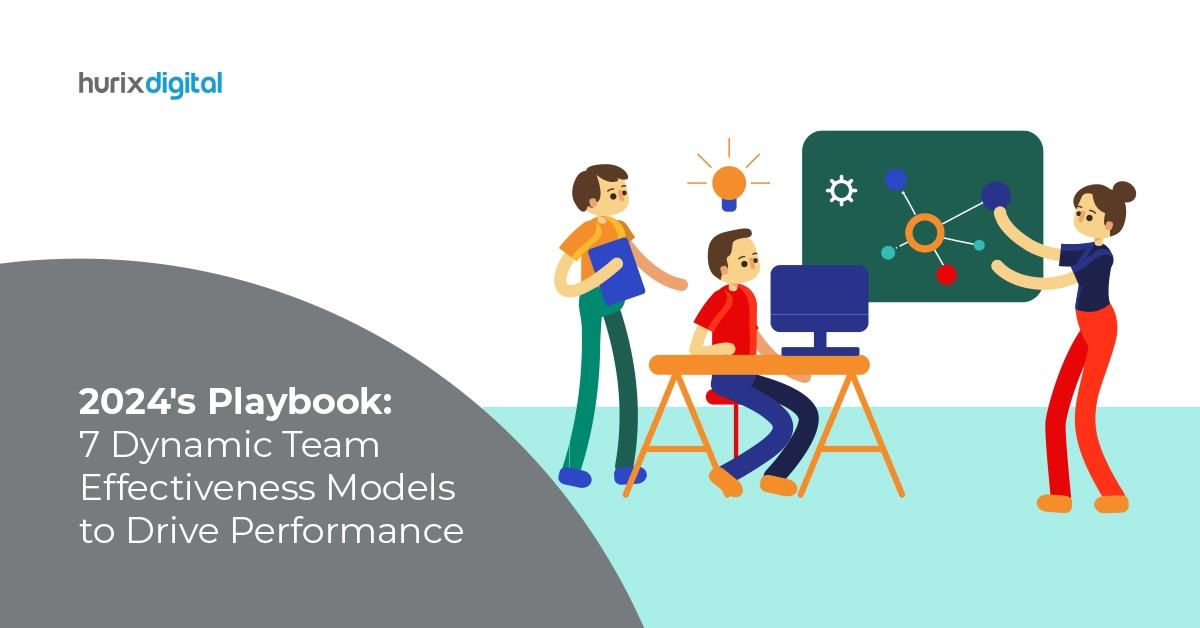
2025’s Playbook: 7 Dynamic Team Effectiveness Models to Drive Performance
Entrepreneurship is growing rapidly, and in order to succeed in the competitive market, you have to be great at what you do. How can you make the average of your team outstanding? That is what the team effectiveness model does.
Implementing strategic performance-boosting strategies and fostering a cooperative work environment can help you maximize your team’s output and eventually achieve exceptional results. This blog will explore seven strong models for improving team effectiveness and raising performance levels.
Table of Contents:
- Seven Dynamic Team Effectiveness Models to Drive Performance
- Why Dynamic Team Effectiveness Models are Critical to Drive Performance in 2025?
- Conclusion
Seven Dynamic Team Effectiveness Models to Drive Performance
Model 1: The Collaborative Matrix
The Collaborative Matrix model is teamwork, open communication, and shared goals. If you work together toward achieving common goals, you are leveraging each person’s strengths and insights and that creates a synergy that is extremely powerful.
With the help of the Collaborative Matrix model, you can take your team towards shared success by working together effectively.
- Teamwork is Key: Encourage your team to work together towards a common objective to pool their skills and expertise for maximum impact.
- Focus on Communication: Effective communication is at the core of this model, as it promotes open communication, active listening, and the exchange of clear ideas among team members for seamless collaboration.
- Use Diverse Strengths: This model leads to optimal performance outcomes by leveraging team members’ diverse strengths and perspectives.
- Build Cohesion: This model cultivates a culture of collaboration and support, strengthening bonds among team members and guiding them toward shared success.
Model 2: The Performance Enhancement Framework
The performance enhancement framework stimulates improvement and growth for each individual to be better within the group.
- Continuous Improvement: This model focuses on the continuous improvement of your team members and encourages them to constantly strive to improve their skills, processes, and outcomes.
- Emphasize Individual Growth: This model strongly emphasizes individual growth, providing opportunities for team members to develop their capabilities and expand their skills. Moreover, aligning with the principles of the performance enhancement framework, research revealed that 79% of employees exposed to formal development programs exhibited higher engagement levels compared to those without such initiatives.
- Targeted Skill Development: By implementing targeted skill development strategies, it offers customized support and resources to enhance competencies crucial to their roles.
- Implement Performance Evaluation: Through effective performance evaluation mechanisms, this model allows team leaders to assess individual and group performance objectively, identify areas for improvement, and provide constructive feedback to drive progress.
- Results-Driven Approach: This model emphasizes setting clear goals, measuring outcomes, and adjusting strategies based on performance data to ensure continuous enhancement and desired results.
Also Read: Measuring the Effectiveness of Translated and Localized Workforce Learning Content
Model 3: The Synergistic Team Approach
The synergistic team method focuses on integrating a diversity of skills, personalities, and knowledge into the team environment.
This model highlights the importance of diversity and inclusion in generating creativity and successful problem-solving.
- Harmonious Skill Blend: This model focuses on creating a harmonious mix of skills within the team, where each member’s strengths complement and enhance the group’s overall capabilities.
- Personality Integration: It helps you recognize the value of integration of different temperaments and working styles to promote creativity and adaptability.
- Unlock Full Potential: By leveraging diverse skills and perspectives, your team can achieve outstanding results that surpass individual contributions. Additionally, encouraging a culture of open communication and collaboration, such as through regular one-on-one meetings, has significantly boosted employee motivation and engagement, with 71% of employees benefiting from such interactions.
Model 4: The Agile Performance Model
The Agile Performance Model is based on adaptability, flexibility, and fast decision-making. It will prepare these teams to tackle challenges in this dynamic environment as they embrace the model, realize opportunities, and maintain superior performance excellence.
- Emphasize Adaptability: Such a model encourages teams to respond with alacrity to changes, pivot, and adjust strategies as required.
- Embrace Flexibility: Embracing flexibility allows teams to explore different solutions, experiment with new ideas, and adapt methods to suit the situation.
- Quick Decision-Making: Rapid decision-making also characterizes this model as teams make decisive action based on timely and informed choices.
- Achieve Sustained Excellence: This model encourages a culture of continuous improvement, learning, and innovation to sustain performance excellence over time and succeed in a competitive market.
Model 5: The Balanced Scorecard Approach
- Comprehensive Evaluation: The Balanced Scorecard Approach provides a well-rounded team performance evaluation. It looks beyond finances to assess customer satisfaction, internal processes, and learning and growth.
- Alignment with Strategic Objectives: This model will ensure your efforts in a team for coherence and synergy of actions of various organizational functions are aligned.
- Effective Progress Tracking: This approach enables you to monitor your organization’s progress in different areas to determine where you need to improve and where you’re succeeding.
- Data-Driven Decision-Making: The Balanced Scorecard empowers teams to make informed choices using performance metrics to enhance your team’s performance continuously.
Model 6: The Team Resilience Framework
The team resilience framework is designed to equip teams with the mindset and tools to not only overcome adversity but also emerge stronger from it.
- Mindset Development: The Team Resilience Framework focuses on cultivating a resilient team mindset, encouraging a positive outlook, adaptability, and perseverance in facing challenges.
- Tool Integration: The given framework consists of practical tools and strategies, equipping the team with the necessary resources to overcome setbacks. Problem-solving skills, collaboration, and innovation are all facilitated through this model.
- Adversity as Growth Opportunity: This model reframes adversity as an opportunity for growth and learning, encouraging teams to view challenges as stepping stones to improvement rather than obstacles.
Model 7: The Continuous Improvement Model
Continuous improvement is central to the working of successful teams. This continuous improvement model really stresses a learning and feedback-centered culture or way of adapting.
In summary, it helps spark innovation, invites experimentation, and even provides the scope to reflect. As a result, teams can consistently enhance performance and maintain a competitive edge in businesses.
- Learning Culture: The continuous improving model encourages team members to acquire new skills, knowledge, and insights to drive growth and development.
- Feedback Mechanisms: This model promotes open communication channels for constructive feedback exchange, enabling teams to identify areas for improvement and implement necessary changes.
- Reflection and Iteration: By reflection and iteration, teams can review past performance, identify successes, and iterate on strategies for greater efficiency and success over time.
Why Dynamic Team Effectiveness Models are Critical to Drive Performance in 2025?
The following are some key factors that highlight why leveraging dynamic team effective models will keep your workforce adaptable, flexible, and continuously evolving.
1. Adapting to Changing Business Scenarios
Businesses exist in a cobweb of constantly changing trends and advancements. New technology appears, market conditions change quickly, and consumer expectations change as well. Static team models frequently find it difficult to adapt to these changes since they are based on inflexible structures and roles that are predetermined.
Conversely, dynamic team effectiveness models are made to be flexible. These models highlight:
- Flexible team structures: Allow roles and duties to be changed as necessary to accommodate changing project demands and objectives.
- Agile Workflows: To address new difficulties, teams can quickly adapt by implementing new procedures or technology.
- Cross-Functional Collaboration: Dynamic teams that combine various skill sets from around the company enable innovative solutions to challenging issues.
Adopting a dynamic approach will keep your staff flexible and responsive, positioning your organization to seize new opportunities and stay ahead of the competition.
2. Enhancing Employee Engagement and Retention
In hiring and training, you might face serious concerns about employee engagement and retention. High turnover, disengagement, and stagnation can result from a stagnant team atmosphere, particularly for top personnel looking for chances for advancement.
In order to overcome these obstacles, dynamic team effectiveness models promote a more interesting and satisfying workplace. Important advantages include:
- Greater Autonomy: Because team members have more authority over their tasks, they can take responsibility for their work and make significant contributions to the team’s objectives.
- Possibilities for Skill Development: Your employees in dynamic teams can broaden their expertise and acquire new skills by taking on new projects or rotating positions.
- Collaborative Culture: Employees working in diversified, cross-functional teams bond better with each other and are exposed to a variety of viewpoints, which enhances job satisfaction overall.
3. Driving Continuous Performance Improvement
Growth and innovation may be constrained by static performance models’ frequent emphasis on defined measures and recurring assessments. By combining data-driven insights, iterative goal-setting, and real-time feedback, you ensure dynamic team effectiveness models place a high priority on ongoing performance development.
Important Elements of Ongoing Improvement:
- Real-Time Input: Team members are able to make quick corrections and advancements because they receive continuous input from supervisors, peers, and performance indicators.
- Data-Driven Decision-Making: Performance data is continuously gathered and examined to identify trends, areas for improvement, and strengths.
- Goal-Setting: Iterative goal-setting involves reviewing and modifying goals frequently to reflect changing team capabilities and your organization’s corporate objectives.
This strategy guarantees that your teams constantly improve, grow from their experiences, and maximize their output to achieve superior outcomes.
Also Read: The Role of Cultural Adaptation in Localizing Workforce Learning Content
Conclusion
In conclusion, incorporating high-performing team models into your organization’s playbook can enhance collaboration, innovation, and performance. Implementing these dynamic strategies can drive performance optimization and achieve sustainable success.
Remember – your journey to success begins with effective teamwork guided by strategic models designed to maximize your potential. Implementing these strategies might be complicated, but you can partner with Hurix Digital to overcome this.
Our team’s expertise lies in guiding organizations to build high-performing teams through tailored digital solutions that optimize team dynamics, goal achievement, and positive enterprise outcomes.





